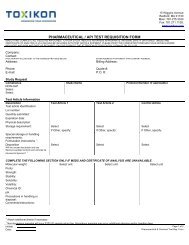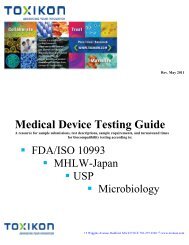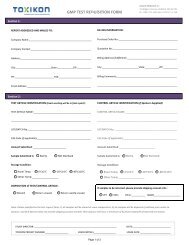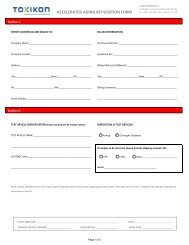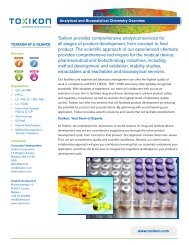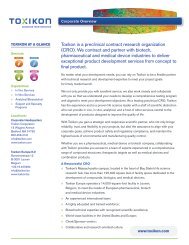Biocompatibility Safety Assessment of Medical Devices ... - Toxikon
Biocompatibility Safety Assessment of Medical Devices ... - Toxikon
Biocompatibility Safety Assessment of Medical Devices ... - Toxikon
You also want an ePaper? Increase the reach of your titles
YUMPU automatically turns print PDFs into web optimized ePapers that Google loves.
Pyrogens are substances in devices that cause a febrile reaction. Bacterial endotoxin<br />
contamination is most commonly associated with such an adverse effect; however,<br />
leachates <strong>of</strong> materials can cause similar febrile responses (material-mediated<br />
pyrogenicity). Material-mediated pyrogenicity assessment is typically included in<br />
biocompatibility assessment, while bacterial contamination and endotoxin-mediated<br />
pyrogenicity are issues related more to manufacturing processes than to biocompatibility<br />
<strong>of</strong> the device or material.<br />
ISO 10993-11 recommends testing the pyrogenicity potential <strong>of</strong> extractable substances<br />
derived from material leaching. ISO 10993 includes the pyrogen test, based on USP<br />
methodology, in the category <strong>of</strong> systemic toxicity testing. The baseline temperature <strong>of</strong> the<br />
rabbits prior to injection provides a basis for comparison.<br />
Table VII<br />
ISO 10993-11 MHLW 2003<br />
Number <strong>of</strong> animals:<br />
Three rabbits required; comparison<br />
<strong>of</strong> febrile response in test animals to<br />
baseline temperature for evaluation<br />
<strong>of</strong> pyrogenicity potential<br />
Test duration:<br />
Test measurement intervals: every<br />
30 minutes for 3 hours<br />
Evaluation:<br />
Cut<strong>of</strong>f for positive febrile response:<br />
0.5°C<br />
Table VII. Comparison <strong>of</strong> pyrogen test procedures required by ISO 10993-11 and the<br />
MHLW guidelines.<br />
MHLW holds the pyrogen test as a separate test category. Material-mediated<br />
pyrogenicity is tested in a manner similar to ISO 10993 by injecting extracts <strong>of</strong> the test<br />
device into rabbits, and measuring the temperature rise at intervals over a 3-hour period.<br />
The major differences between the ISO and MHLW recommendations for testing<br />
systemic toxicity and pyrogenicity potential are outlined in Table VII.<br />
TESTS FOR GENOTOXICITY<br />
ISO 10993-3, "Tests for Genotoxicity, Carcinogenicity, and Reproductive Toxicity,"<br />
recommends that the potential for genetic toxicity be assessed using a series <strong>of</strong> at least<br />
three assays. Two <strong>of</strong> these assays should use mammalian cells as the test system, and the<br />
tests should cover the three levels <strong>of</strong> genotoxic effects: DNA effects, gene mutations, and<br />
chromosomal aberrations. The International Conference on Harmonization (ICH)<br />
11<br />
Three rabbits (test) required;<br />
comparison to baseline<br />
temperature is evaluated as<br />
index <strong>of</strong> pyrogenicity potential<br />
Test measurement intervals:<br />
every hour for 3 hours<br />
Cut<strong>of</strong>f for positive febrile<br />
response: 0.6°C



